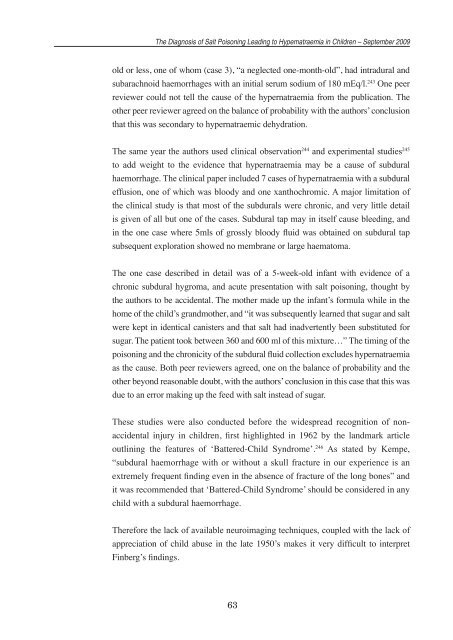The differential diagnosis of hypernatraemia in children, with ...
The differential diagnosis of hypernatraemia in children, with ...
The differential diagnosis of hypernatraemia in children, with ...
Create successful ePaper yourself
Turn your PDF publications into a flip-book with our unique Google optimized e-Paper software.
<strong>The</strong> Diagnosis <strong>of</strong> Salt Poison<strong>in</strong>g Lead<strong>in</strong>g to Hypematraemia <strong>in</strong> Children – September 2009<br />
old or less, one <strong>of</strong> whom (case 3), “a neglected one-month-old”, had <strong>in</strong>tradural and<br />
subarachnoid haemorrhages <strong>with</strong> an <strong>in</strong>itial serum sodium <strong>of</strong> 180 mEq/l. 243 One peer<br />
reviewer could not tell the cause <strong>of</strong> the <strong>hypernatraemia</strong> from the publication. <strong>The</strong><br />
other peer reviewer agreed on the balance <strong>of</strong> probability <strong>with</strong> the authors’ conclusion<br />
that this was secondary to hypernatraemic dehydration.<br />
<strong>The</strong> same year the authors used cl<strong>in</strong>ical observation 244 and experimental studies 245<br />
to add weight to the evidence that <strong>hypernatraemia</strong> may be a cause <strong>of</strong> subdural<br />
haemorrhage. <strong>The</strong> cl<strong>in</strong>ical paper <strong>in</strong>cluded 7 cases <strong>of</strong> <strong>hypernatraemia</strong> <strong>with</strong> a subdural<br />
effusion, one <strong>of</strong> which was bloody and one xanthochromic. A major limitation <strong>of</strong><br />
the cl<strong>in</strong>ical study is that most <strong>of</strong> the subdurals were chronic, and very little detail<br />
is given <strong>of</strong> all but one <strong>of</strong> the cases. Subdural tap may <strong>in</strong> itself cause bleed<strong>in</strong>g, and<br />
<strong>in</strong> the one case where 5mls <strong>of</strong> grossly bloody fluid was obta<strong>in</strong>ed on subdural tap<br />
subsequent exploration showed no membrane or large haematoma.<br />
<strong>The</strong> one case described <strong>in</strong> detail was <strong>of</strong> a 5-week-old <strong>in</strong>fant <strong>with</strong> evidence <strong>of</strong> a<br />
chronic subdural hygroma, and acute presentation <strong>with</strong> salt poison<strong>in</strong>g, thought by<br />
the authors to be accidental. <strong>The</strong> mother made up the <strong>in</strong>fant’s formula while <strong>in</strong> the<br />
home <strong>of</strong> the child’s grandmother, and “it was subsequently learned that sugar and salt<br />
were kept <strong>in</strong> identical canisters and that salt had <strong>in</strong>advertently been substituted for<br />
sugar. <strong>The</strong> patient took between 360 and 600 ml <strong>of</strong> this mixture…” <strong>The</strong> tim<strong>in</strong>g <strong>of</strong> the<br />
poison<strong>in</strong>g and the chronicity <strong>of</strong> the subdural fluid collection excludes <strong>hypernatraemia</strong><br />
as the cause. Both peer reviewers agreed, one on the balance <strong>of</strong> probability and the<br />
other beyond reasonable doubt, <strong>with</strong> the authors’ conclusion <strong>in</strong> this case that this was<br />
due to an error mak<strong>in</strong>g up the feed <strong>with</strong> salt <strong>in</strong>stead <strong>of</strong> sugar.<br />
<strong>The</strong>se studies were also conducted before the widespread recognition <strong>of</strong> nonaccidental<br />
<strong>in</strong>jury <strong>in</strong> <strong>children</strong>, first highlighted <strong>in</strong> 1962 by the landmark article<br />
outl<strong>in</strong><strong>in</strong>g the features <strong>of</strong> ‘Battered-Child Syndrome’. 246 As stated by Kempe,<br />
“subdural haemorrhage <strong>with</strong> or <strong>with</strong>out a skull fracture <strong>in</strong> our experience is an<br />
extremely frequent f<strong>in</strong>d<strong>in</strong>g even <strong>in</strong> the absence <strong>of</strong> fracture <strong>of</strong> the long bones” and<br />
it was recommended that ‘Battered-Child Syndrome’ should be considered <strong>in</strong> any<br />
child <strong>with</strong> a subdural haemorrhage.<br />
<strong>The</strong>refore the lack <strong>of</strong> available neuroimag<strong>in</strong>g techniques, coupled <strong>with</strong> the lack <strong>of</strong><br />
appreciation <strong>of</strong> child abuse <strong>in</strong> the late 1950’s makes it very difficult to <strong>in</strong>terpret<br />
F<strong>in</strong>berg’s f<strong>in</strong>d<strong>in</strong>gs.<br />
63

















